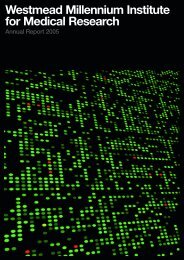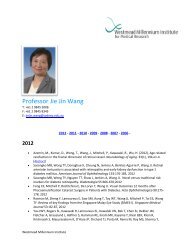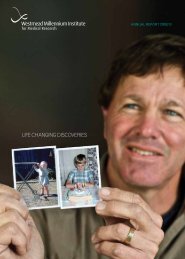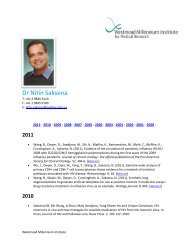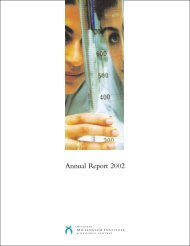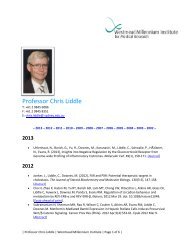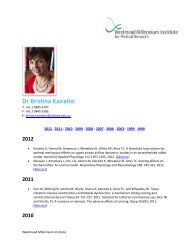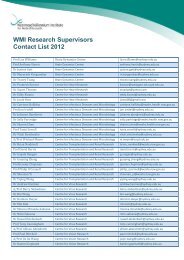Translating >> - Westmead Millennium Institute
Translating >> - Westmead Millennium Institute
Translating >> - Westmead Millennium Institute
Create successful ePaper yourself
Turn your PDF publications into a flip-book with our unique Google optimized e-Paper software.
20 21 > Overview // AR 2006<br />
Cardio-respiratory<br />
Laboratory and clinical studies are combined by respiratory researchers<br />
hoping to identify breathing and sleep disorders linked to or resulting from<br />
a disease or injury.<br />
The Cardio-respiratory division combines laboratory<br />
research and clinical studies to enhance our understanding<br />
of common cardio and respiratory disorders like abnormal<br />
heart rhythms and sleep disorders.<br />
The Centre for Heart Research is focused on finding better<br />
treatments for patients with abnormal heart rhythms and to<br />
cures these conditions.<br />
Ventricular trachycardia (VT) is a debilitating condition that<br />
causes the heart to beat rapidly, affecting the heart’s pumping<br />
chambers or ventricles. It usually occurs when the heart<br />
muscle has sustained damaged from previous heart attacks<br />
and can cause sudden death.<br />
VT is treated using a defibrillator, a device which triggers a<br />
painful electric shock to normalise the heartbeat. A therapy<br />
can be applied which modifies abnormal electrical activity<br />
responsible for VT, reducing the need for patients to undergo<br />
the electric shocks. This method uses radiofrequency ablation<br />
to heat the heart tissue using electrical energy to destroy<br />
small regions responsible for VT. To locate these areas more<br />
effectively, researchers are working on a three-dimensional<br />
mapping system, which is based on satellite navigation<br />
technology, to guide clinicians directly to the scarred areas.<br />
Researchers are also developing a novel catheter, which<br />
is positioned within the patient’s heart to indicate where<br />
abnormal electrical activity is originating from. This can be<br />
done from a single abnormal heartbeat, which is a major<br />
improvement on previous methods. The ultimate aim for<br />
researchers is to perfect these innovations so patients with VT<br />
may be cured of the condition.<br />
Researchers have also been working on improving outcomes<br />
for patients with atrial fibrillation (AF), rapid heart-beating in<br />
the upper heart chamber, which leads to stroke in about 15<br />
per cent of people aged over 75 years.<br />
Technology developed in France to isolate electrical triggers that<br />
cause AF is being offered to <strong>Westmead</strong> Hospital patients as an<br />
alternative to medication or open-heart surgery. Researchers at<br />
the centre are working to improve the 70 per cent efficacy of<br />
this treatment and to improve the procedure’s success rate.<br />
Among other projects, researchers have begun collaborating<br />
with <strong>Westmead</strong> Hospital’s cardiothoracic unit to investigate<br />
ways of refining the artificial mitral valve used to replace the<br />
diseased valve in patients.<br />
The Ludwig Engel Centre for Respiratory Research aims to<br />
improve the quality of life for patients with respiratory and<br />
sleep-related respiratory diseases.<br />
The centre primarily researches the causes, consequences<br />
and potential new treatments of the obstructive sleep apnoea<br />
syndrome, a disorder affecting about 800,000 Australians.<br />
Other research areas include cystic fibrosis, asthma and<br />
chronic obstructive pulmonary disease.<br />
Patients with sleep apnoea experience repeated episodes<br />
of throat blockage during sleep, which stops them from<br />
breathing for short periods of time. The disorder results<br />
from snoring and obstructed breathing and is linked to<br />
hypertension, heart failure, heart attacks as well as stroke.<br />
Over the past year, researchers have been looking at the<br />
role heavy snoring may play in triggering stroke. Vibrations<br />
caused from heavy snoring travel in tissues surrounding<br />
the airways to the carotid arteries found in the neck, which<br />
supply blood to the brain. Researchers are investigating<br />
whether this may exacerbate atherosclerosis (hardening) in<br />
the carotid arteries eventually leading to stroke.<br />
Clinical studies yet to be published on a group of 110<br />
patients with varying degrees of heavy snoring and mild sleep<br />
apnoea showed heavy snoring was associated with a 10- to<br />
17-fold increase in the risk of carotid artery vascular disease.<br />
As research continues, approaches to treatment may alter to<br />
include more regular screening of carotid arteries in patients<br />
who snore heavily and increased research into preventative<br />
therapies for the condition.<br />
Studies over the past year have also assessed the efficacy of<br />
a rehabilitation program designed to minimise hospital<br />
admissions and improve quality of life and wellbeing in<br />
patients with chronic obstructive lung disease. The program<br />
uses a combination of aerobic exercise, education, clinical<br />
support and medication optimization. This successful<br />
combination has been shown to add 60 metres to patients’<br />
walking distance and reduce hospital admission rates over<br />
two years following completion of the program and improve<br />
general wellbeing.



